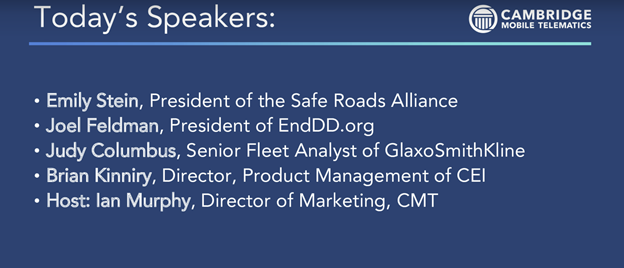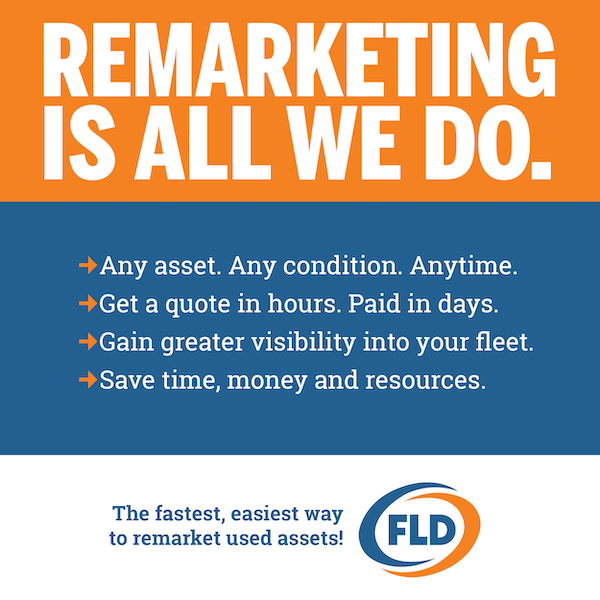
By Ed Pierce, Contributing Editor
Cambridge Mobile Telematics recently gathered a panel of experts for its webinar, “The Road to Safety for Your Fleet Drivers: Why Behavior Change is Key to Eliminating Distracted Driving.” The panel included Judy Columbus, senior fleet analyst for GlaxoSmithKline; Brian Kinniry, Product Development Director for CEI; Emily Stein, president of the Safe Roads Alliance; Joel Feldman, president of EndDD.org. CMT director of marketing Ian Murphy served as host.
Here are some of the highlights of the Q&A session:
Q: Based on your experience, would you say that we’re making headway into educating drivers about the dangers of distracted driving? GSK has a fairly large sized fleet, and I know that you’ve really had some experience trying to end distracted driving.
A: Judy Columbus, GlaxoSmithKline
At GSK, we’ve had the safety program for over 25 years. We’ve been with CEI for just about that long and work with their team to ensure that our training is up to date and relevant to the times. We work with them to discover any trends and also reeducate our drivers.
We’re trying to keep drivers aware of the need for safe driving not just when something happens to a colleague, but on a permanent basis. We want them to realize that no driver can do double duty. Their focus must be on the road. We’re focused on changing behaviors through continuous training. We let them know best practices. We involve managers in the effort to drive down the number of incidents. I believe that drivers are becoming a little bit more aware, but it’s a continuous effort.
A: Joel Feldman, End.DD.org
I have seen cases that have been done well, including policy development and adoption; obtaining buy-in from different levels of the company to prioritize safety including the creation of committees comprising different managers at different levels to adopt that policy; and finally, implementing effective safety programs that change driver behavior.
If you get buy in from the top, the CEOs and everyone else, you’re going to do a pretty good job of changing behavior. While many companies I have met still do not have policies yet, they recognize the need to implement a safety program to address distracted driving.
Q: What are some of the obstacles in educating fleet drivers and some of the successes?
A: Brian Kinniry, CEI:
What we’ve seen among our CEI customers is that awareness campaigns can make drivers and even their families aware of the dangers of distracted driving. I think still the challenges are in the policies. However, the National Safety Council recently conducted research that indicated 46% of employees feel that demands of work and the inability to even take breaks lead them to either read or send emails while driving.
I think there’s still a big opportunity for companies and organizations as well as senior leadership on down to make the well-being of drivers top of mind as part of their strategic planning. That shows a true commitment to a safety culture.
Granted, everyone’s so busy. That a constant, but companies cannot make employees feel so pressured to perform that they put themselves at risk. A safety culture is all about accountability for management and drivers alike. Each action and each decision must be measured by its impact on safety just like a company measures profitability, productivity, quality, or customer satisfaction.
Q: What are some of the issues related to reconciling the pressure to stay connected the need to accept personal responsibility when one gets behind the wheel?
A: Emily Stein, Safe Roads Alliance
I used to work as a visiting nurse. When I took a call from my employer, the first question was, “Are you safe to talk?” It made me think, “Oh, they care about me.” It also served as a reminder that I should not be using the phone to schedule patients, to have calls from doctors and nurses. I must do these things before driving the car.
Personal accountability is something as simple as changing the voicemail so it says, “You’ve reached so-and-so, and I’m driving or busy and I can’t talk. I’ll call you when it’s safe to do so.” That shows that I respect myself and I keep myself safe. It also spurs the caller to rethink their own behavior.
A: Judy Columbus
We want to make sure that this message is coming directly from the managers to the employees. We can send all kinds of reminders and do all kinds of training, but whatever’s important to the direct manager is going to be important to the employee. We make an effort to reach out to the managers to make sure that they’re reinforcing our focus on safety and that they believe it. We will do everything we can to bring our drivers home safely every night.
We have that commitment from our leaders, and it is part of a global initiative at GSK. It has been a part of GSK policy for a very long time, but the more drivers they put on globally, the more employees realize that enforcing safe driving is a priority.
Q. Are vehicle manufacturers’ safety features helping or distracting drivers?
A: Judy Columbus
A few years ago, we made sure that all of our fleet vehicles were going to include as many safety features as possible, including cameras, collision warning, and so on. The technology can help. However, we still try to reinforce with our drivers a few caveats: first, make sure you know how to use the technology. We worked with CEI to add additional training to ensure drivers knew how to use their mirrors because as soon as you add back-up cameras, drivers begin backing into more things. We needed to make sure they were aware how to use that back-up camera while still using their rearview mirrors.
In general, we reiterate that even though a driver has all of this technology, it doesn’t replace safe driving practices, but only helps to enhance it. Drivers still need to turn their heads. They still need to use their mirrors. They still need to pay attention.
A: Emily Stein
Specifically related to phone technology, our organization believes that the vehicle is a driver’s sacred space. Put the phone away.
I think, with all these additional safety features, they can be great, but my concern is it might allow the driver to disengage. They might become bored and more tempted to use their phone. I worry about inviting more reasons to be distracted into the car.
A: Joel Feldman
The addition of safety features lets drivers know that the company cares about them. I was doing a talk for a utility company in New England, describing how it felt to lose a daughter. I said, “I’m sure it’s not good on the other side of the distracted driver.”
A guy raised his hand and proceeded to tell 150 of his fellow employees how he had killed someone 16 years ago — a boy on a bike. He said he still sees him in his dreams. While I think I did a really good job in that talk, the employees surely were more impacted by sharing such stories.
Companies that invite me to speak don’t want me to talk about legal liability. They really care about their employees and want them to be safe on the job. They want them to get home safe to their families.
I think companies can be successful with this approach. They do not want drivers thinking that they are taking away something by eliminating distractions. Instead, they are giving drivers something. By not driving distracted, we are giving them something.
A: Brian Kinniry
I think the Insurance Institute for Highway Safety did a study sometime last year that found that with driver-assist features, folks were actually 12 times more likely to take their hand off the wheel. It put folks into a state of being comfortable thinking that this technology allows them to relax rather than sharpen their skill sets such as adjusting mirrors and creating safety zones.
The technology is very important when it’s utilized properly. That’s why our company is focused on training drivers on how to properly utilize the technology, yet not to be so dependent on it all the time.
Q: Do you think training is enough, or does a company need to deliver other messaging?
A: Brian Kinniry
Training is important. I also think having, not just senior leadership, but frontline managers, proactively involved is critical. The availability of safety features by the company sends a message to the employee that the company is investing in their safety. But if safety is important to my boss, then it’s going to be important to me.
Drivers generally feel that the company cares about them when their manager is setting that example. Just as I had said earlier about the pressures of having to complete tasks and things on the job, if the manager’s constantly putting the employees’ safety first through messaging and communications, the employee’s going to feel like the company cares about safety first and foremost.
Q: Do you think there are factors companies may not be considering or some things they’re even overlooking with distracted driving?
A: Joel Feldman
I did a talk to drivers at a Kentucky utility company. Both at headquarters and field offices. I started with a field office first and saw a wall with a whole bunch of pictures of employees with their children. Above the pictures were the words, “Safety is R-I-G-H-T, The Reason I Home Tonight.” I think there are so many things that employers can do to show they care.
Some of the other companies that I’ve been really impressed with promote the idea that “Hey, we want you to take this message home to your families. We’re a family here, and your families are part of our extended family.”
Editor’s note: Next week, we wrap up the Highlights from Cambridge Mobile Telematics’ Fleet Road Safety Panel Discussion





